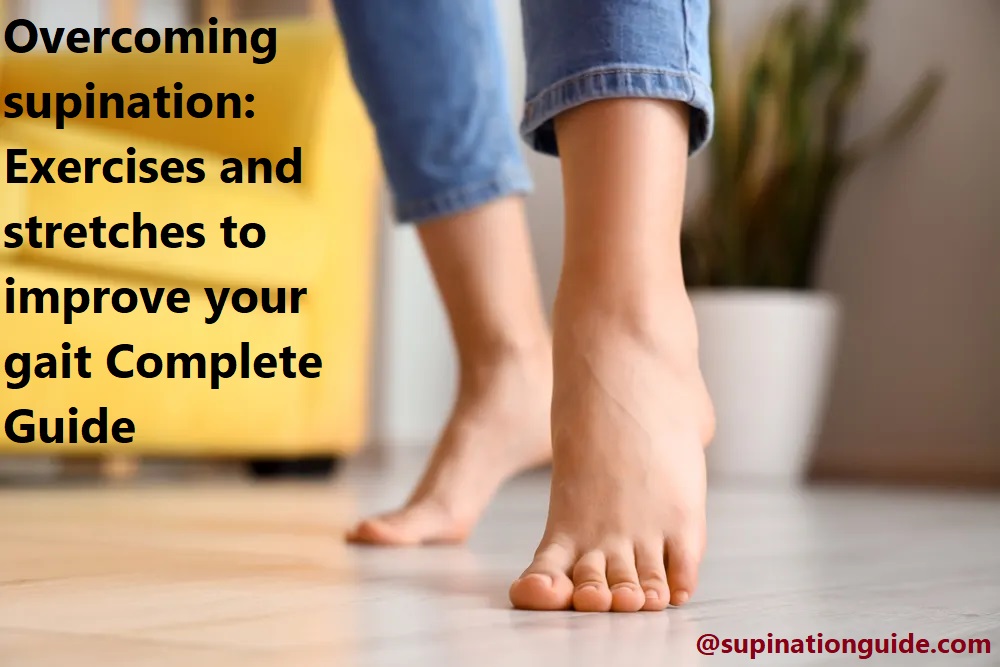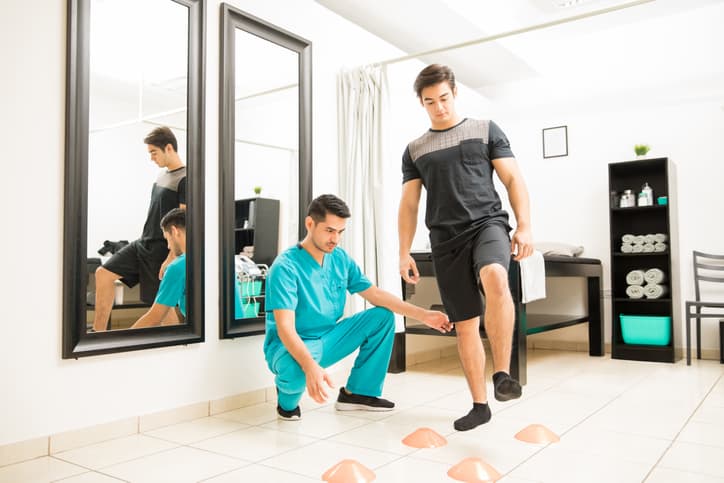Have you been experiencing pain and discomfort due to supination? With this guide, you can learn how to improve your gait and manage pain associated with supination.
Here, unlock tips and exercises to help you gain better control of your lower body and reduce the risk of further injury.
Supination is the tendency to wear down the outside or outer part of your feet as you walk and run which can cause a variety of issues, including increased risk of ankle injury, knee pain and back pain. The good news is that there are interventions that can help. This guide will provide an overview of what causes supination, and outlines some exercises and stretches to help improve your gait and reduce the risk of injury.
We will cover:
- Overview on supination
- Identifying if you have supination
- The role of shoes in alleviating supination
- Exercises to help correct tension imbalances associated with supination
- Stretches that targets muscles used for walking and running
At the end of this guide, we want readers to have a better understanding about how addressing supination through both exercise and stretching can prevent future injuries.
Causes of Supination
The condition of supination can be caused by weak, unstable muscles or poor biomechanical control of the feet. Many conditions can affect the gait of a person, such as foot deformities, previous ankle sprains, muscular weakness, tightness in certain muscles or ligaments and incorrect shoe wear. All these conditions can contribute to supination or excessive pronation and it is important to identify and address the root cause in order to successfully manage foot mechanics.
In order to determine the source of a patient’s supination, physicians will often perform a full physical exam as well as an orthopedic examination or gait analysis. This helps them to identify any physical abnormalities that may be impacting their gait and leading to supination. Once they have identified the root cause of their condition, they can then focus on exercises and stretches which help to improve biomechanical control and strengthen weak muscles in order to restore healthier movement patterns.

Anatomy of the foot and ankle
The foot and ankle are complex structures composed of 26 bones and 33 joints, plus a network of ligaments, muscles and tendons that protect the area while facilitating movement. This anatomical complexity needs to be taken into account when looking at supination or excessive pronation, known as overpronation.
Understanding the anatomy of the foot and ankle can help to identify these issues. The foot is divided into three sections: hindfoot, midfoot, and forefoot. The hindfoot comprises the calcaneus (heel bone) and talus (ankle bone). The midfoot is made up of three small arches of bones supported by ligaments and four groups of muscles. These bones connect at the metatarsophalangeal (MTP) joint in the forefoot to form five toes.
Between each toe lies five metatarsal bones that make up the middle part of your foot (the ball) as well as numerous small muscles on each side known as intrinsci muscles. These intrinsics work together with other muscles on top of your foot like extensor digitorum brevis, fibularis tertius, extensor hallucis longus to impart strength to plantarflexion movement when you walk or run. The Achilles tendon — connecting your heel bone to your calf muscle — also plays an important role in keeping you balanced by controlling dorsiflexion in many activities such as jumping or fast running.
Genetic factors
It is important to note that some issues with supination are the result of genetic factors, meaning there is no “cure” for it. Therefore, it is important to focus on ways to compensate and manage your condition rather than thinking of it as a problem that needs fixing.
The first step in doing this is understanding how the muscles in your legs and feet work together. The three main muscle groups that play a role in supination are the large quadriceps femoris muscle group that runs from the hip down to the knees, the tibialis anterior and posterior muscles found on either side of the shin bone, and finally the calves. As these muscles work during ambulation, they can create an imbalance in foot mechanics which leads to overpronation or supination.
It’s also important to understand how genetics plays a role in determining which type of foot mechanics you may possess. Specifically, having certain genetic variants may predispose you to certain gait problems such as overpronation or supination. Identifying potential risk factors can help you better target treatment plans and correct imbalances if they exist.
The next step is recognizing what kind of exercise program best works for you based on your specific needs as someone with supination. Generally, exercises should be focused on strengthening and stretching opposing muscle groups; strengthening activities such as toe curls or calf raises should be balanced out with gentle stretches like those found through yoga or Pilates classes. Furthermore, engaging in regular physical activity can help increase strength endurance while also reducing muscular asymmetries associated with gait abnormalities like supination.
Improper footwear
While there are many lifestyle and environmental factors that can lead to supination, by far the most common culprit is improper footwear. Shoes that don’t provide sufficient arch support can cause your feet to compensate by pronating or supinating excessively. This biomechanical misalignment accelerates the wear and tear on certain ligaments and tendons in your feet, which leads to pain and injury.
To ensure optimal foot health, it’s important to invest in a quality pair of shoes specifically designed for support. Look closely at the shoes you plan on buying as some may not have enough cushioning or stability features necessary for addressing overly-pronated or supinated conditions. Choose shoes with a solid heel counter designed to lock your foot into place, extra toe room for natural movement, copious cushioning in the midsole and forefoot areas, arch support where you need it most, and good traction on the outsole for enhanced grip on different surfaces.
Muscle imbalances
When you experience supination of the foot, it is often a result of muscle imbalances throughout the body. Muscles on the outside of your lower leg tend to be tight and overactive, while muscles on the inside of your lower leg tend to be weak and underactive. To counteract any deficiencies caused by prolonged supination, strengthening and stretching exercises can help target those muscles that are lacking in strength or flexibility.
For beginners, focusing on exercises that strengthen the weaker, neglected muscles should be emphasized. Leg lifts can help strengthen and activate smaller muscles including anterior tibialis, extensor hallucis longus, peronals fascia latae and gastocnemius medialis. Exercises such as standing calf raises can help strengthen calf muscles while leg extensions can target quadricep muscles.
Stretches are also important for loosening up tight muscles when recovering from supination injuries. Stretch your IT band with a standing side stretch or lying side stretch pose; your calf with a wall stretch; quads with a kneeling quadriceps stretch; hamstrings with a seated hamstring stretch; ankle joint lateral flexors with an ankle joint moblization; adductors with an adductor mobilization; glutes with a laying gluteal moblization; hip flexors with a lunge pose; or abductors (torso turn) by leaning to one side in warrior two pose and extending the opposite arm up toward the ceiling for ten breaths each pose for several repetitions per day.
Diagnosis of Supination
An assessment of how a person’s feet move during walking and running is called a gait analysis. It can help diagnose the underlying cause of a person’s foot pronation or supination. A person should speak to their healthcare provider to determine if they need an evaluation for such conditions as flat feet or overpronation, which can lead to illnesses such as plantar fasciitis.
The provider will analyze the patient’s entire body during walking and running, including:
- Body posture
- Foot anatomy
- Walking speed and pattern
- Muscle contraction strength
- Footwear choice and fit
If supination is diagnosed, a doctor or physical therapist may suggest exercises and stretches that focus on strengthening the muscles that support the foot, ankle and lower leg. The goal of this treatment is to improve the patient’s gait.
Observation of gait
Observing and understanding your gait is one of the first steps to correcting supination. This can include videotaping your stride as you walk or run, or capturing a 3-dimensional image of your foot (such as a flat-foot scan) that is taken by special machines at some health care centers. Assessing muscles, tendons and joints can be particularly helpful in diagnosing the cause of supination.
Doctors may also recommend a gait assessment which involves having the patient walk on a special treadmill while being observed from behind by medical personnel. This type of assessment helps healthcare professionals track movement in different areas of your body while you’re walking or running. It can be useful in detecting changes in leg position and pressure across the foot to identify over-supination and inform treatment plans.
Physical examination
It is important to consult with a physical therapist or physician to diagnose any underlying causes of supination and any functional limitations it may present. A physical examination will typically include evaluation of your range of motion and strength. Most importantly, the physical therapist or doctor will observe your gait during walking and observe which muscles are weak, tight, or inhibited.
Furthermore, they can assess the structures in your lower extremity that are bearing the brunt of the forces incurred during walking and running. Depending on their findings, they may recommend additional imaging such as X-ray or MRI so that they can optimize their treatment plan.
Foot analysis
Foot analysis is an important part of assessing gait, and it can help identify the underlying cause of supination. Signs such as excessive wear on the outside of your footwear, the presence of calluses or irregular bone shape may suggest supination. To fully assess the condition, biomechanical analysis and force measurements should be taken while walking or running. This can provide information such as foot angle at ground contact, forefoot posture at push-off, heel strike force and more.
A professional assessment by a physical therapist or podiatrist can be helpful in confirming an overpronation diagnosis. Additionally, orthoses may be recommended to provide arch support or motion control to help correct your gait mechanics.

Exercises to Improve Supination
It is important to note that exercises should be chosen based on an individual’s physical abilities and limitations. If needed, guidance should be sought from a medical professional or certified Physical Therapist prior to undertaking any exercise regimen. Improving supination can be achieved through a series of targeted exercises that focus on engaging the foot, ankle, and lower leg muscles. Here are some suggested exercises for people wanting to strengthen their feet, ankles and lower legs for improved supination:
- Calf Raise – This simple exercise can help build overall strength in the calf muscle and also help improve balance. To do a calf raise, stand up tall with your hands on a wall or stationary object to provide stability. Slowly rise up onto your toes while pushing off the floor with your heels until they come off the ground completely. Hold the position for approximately two seconds before slowly lowering your heels back to the ground. Repeat this 10-15 times in multiple sets with rest periods between each repetition
- Towel Curl – This exercise is designed to strengthen the foot muscles by using an item like a towel as resistance materiala Towel curl involves placing a towel on the floor and curling it towards yourself with your toes until you have it rolled up as tightly as possible in one hand Then slowly release it back out until it reaches its original starting point of being flat against the floor. Do 10 repetitions of this exercise per set for best results
- Heel Walks – Increase ankle strength through heel walksThis exercise works by strengthening each side of your ankle independently Point toes forward then walk only on heels trying not to roll inwards or outwards Repeat three rounds of walking five steps forward and then five steps backwards taking short breaks between sets
Stretch Often –Finally strengthening muscles is important but at least equal importance should also be placed on stretching before doing any activity Doing slow controlled stretches will not only help promote flexibility but will also help protect against injury Dynamic stretches like reaching up high and then down low while keeping abs tight are all excellent ways to warm up prior to physical activity.
Strengthening exercises
Strong feet and an even, neutral gait can help to reduce or even prevent the likelihood of suffering from supination. It is possible to achieve this goal with the right exercises and stretches. The following strengthening exercises can help you build strength in your feet so that they properly support your body weight as you walk or run.
Lower Leg Exercises: These exercises involve contracting individual muscle groups of the calf and ankle to strengthen that part of your body. Examples include heel raises, calf raises, single-leg balance stands, and ankle circles.
Foot Exercises: Strengthening your feet can make them better support you as you transition from heel-strike to midfoot strike while walking or running. Examples include foot abductor/adductor exercises, marble pick ups, towel scrunches, and manual toe spreads.
Straight Leg Lifts: This exercise helps to isolate the lower leg muscles indepependently from other parts of the body for a thorough workout for the area surrounding your foot’s arch region. Straight leg lifts involve lying face up on a flat surface with one foot extended off the ground at a 45 degree angle while bringing it back up in a slow controlled motion while keeping your knee straight throughout the exercise.
Standing Toe Taps: Standing toe taps are another exercise which appropriately works out key muscle groups along the lower section of your body responsible for managing feet pronation when walking or running on hard surfaces. The movements involve setting yourself in an upright position while slowly tapping each toes downwards and releasing back up again until all ten toes have been targeted. For best results repeat this exercise at least 10 times per set before taking a brief break before tackling another one with increased reps and sets.
Balance exercises
Balance exercises can help with supination by strengthening the muscles of the lower body and improving proprioception. These exercises can also improve coordination and balance, which can help to prevent injuries by allowing the body to respond quickly to changes in terrain. Here are some effective ways to increase your balance abilities and achieve better gait performance when dealing with supinated feet:
- Single-Leg Balance: Stand on one foot keeping eyes focused ahead. Hold for up to 30 seconds, switch legs and repeat up to 6 times each side daily.
- Standing Leg Abduction: Stand on both feet with a slight bend in the knees and firmly press into the sides of your feet until both legs are spread wide apart in a V-stance position whilst still pressing within the side walls of each foot. Hold for 5-10 seconds or whatever is comfortable before slowly returning back to starting position.
- Squat Stance Balance Reach: Begin standing with feet hip-width apart and a slight bend in the knee joints. Squat down very low and reach one arm out towards straight ahead (in parallel). Make sure you maintain balance without any leaning forwards or sideways – hold this position for 10 seconds before changing arms/sides.
Flexibility exercises
Flexibility exercises can help improve the range of motion in your feet and ankles. In turn, this can improve foot supination and gait. The following exercises should be done two to three times weekly for best results.
Static calf stretch: Stand upright on a step or ledge with one foot in front, hanging off the edge of the step. Let all your weight rest on your heel of your back foot. Hold this position for 15 to 20 seconds and then repeat on the other side. You should feel a good stretch throughout your calf area but not pain.
Ankle circles: Sitting or standing up with your legs straight, trace small circles on the floor with each ankle joint at least 10 times clockwise and counterclockwise before switching to the other side. This will help promote flexibility in both joints, working out any tightness or rigidity that may be causing supination issues when walking or running.
Seated plantar flexion: Sit down with one leg extended and press down into the floor using only your toes while keeping your heel firmly planted on the ground. Hold this position for 10-15 seconds and then move onto the other side before slowly releasing from the movement and slowly coming back up to a sitting position again as needed. This exercise can help strengthen both ankle and foot musculature when done regularly which may lead to improved supination symptoms over time as well as improved gait mechanics during activities like walking or running.
Conclusion
Supination can be improved with the proper treatment and exercises. Along with exercising and stretching on a regular basis, strengthening the muscles in your feet and ankles is key for good posture and balance.
Focusing primarily on controlling your foot motions, balancing yourself with your arms, activating the muscles around your heel, lifting curved toes up from the ground and doing calf raises are great beginning steps to improving supination-related issues.
By routinely stretching and strengthening your feet, ankles and calves you can start to transition into a more balanced gait pattern that reduces ankle pronation as well as supination-related problems. As with any physical activity or exercise program, it is always important to talk to your health care provider before starting any new routines or activities.

FAQ’s
How do you fix supination gait?
Supination gait can be fixed by wearing proper shoes, doing exercises to strengthen weak muscles, and using custom-made orthotics.
What is a strengthening exercise for supination?
Calf raises, toe curls, and ankle eversions are some of the strengthening exercises that can help with supination.
How can I improve my walking gait?
Improving walking gait can be achieved through various methods such as practicing good posture, wearing proper shoes, and doing gait training exercises.
What muscles are weak with supination?
The muscles that are commonly weak with supination are the peroneus brevis, peroneus longus, tibialis anterior, and extensor digitorum longus.
What is the strongest muscle for supination?
The strongest muscle for supination is the biceps brachii muscle located in the upper arm.
What shoe is best for supination?
Neutral or cushioned shoes with good arch support and shock absorption are the best options for supination.
Can you cure supination?
Supination cannot be cured completely, but it can be managed through various treatment methods such as wearing proper shoes and using orthotics.
What type of insole is used for supination?
Insoles with a deep heel cup and arch support are recommended for supination.
Are wide shoes better for supination?
Wide shoes are not necessarily better for supination, but shoes with a wider toe box can provide more room for the toes and reduce pressure on the foot.
What causes extreme supination?
Extreme supination can be caused by various factors such as genetics, anatomical abnormalities, and muscle imbalances in the foot and leg. It can also be a result of wearing shoes that do not provide enough.
See Also :
- Best sneakers for supination
- Best asics shoes for supination
- Best tennis shoes for supination
- Best walking shoes for supination
- Best womens running shoes for supination


